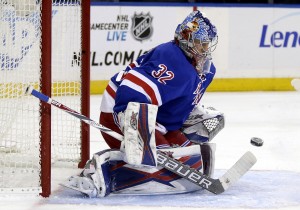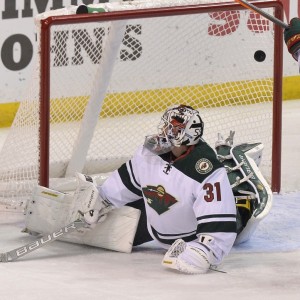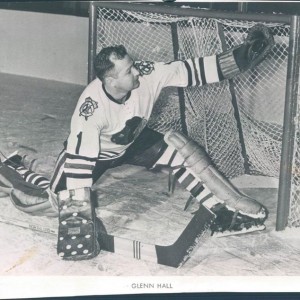Has the horse been beaten? Yes. But is it a horse worth beating? Absolutely.
Several of my colleagues here at The Hockey Writers have already discussed the controversial topic that keeps making its way back into the hockey world for discussion, for various reasons (*cough cough* Mike Babcock). The non-existent issue of scoring in the NHL is something that Babcock has hit on several times, in an attempt to sway the hockey world to increase the size of nets, in order to produce more scoring across the NHL.
I’m here to tell you why it’s a flat-out bad idea.

Why?
Let’s start with the simple question: Why would the NHL make nets bigger? The NHL seems to think that an increase in goal scoring would draw in more fans, as if there’s some sort of solid proportion between the number of goals scored and the number of fans that attend a game. Would it? Who knows, we haven’t tried it, but is that really the best solution that the NHL has?
Why Not:
After all there’s plenty of reasons that the NHL should dispose of any plans that see to the increase of net sizes. For one, if you don’t think that a goalie battle that heads into overtime at 0-0 is an entertaining game, then a far as I’m concerned, you’ve got a few screws loose. A game with few goals does not equal a game with few scoring chances. In fact, I feel that games with less scoring are often times even more exciting, because you’re just that much more anxious whenever the puck enters an offensive zone.
On top of that, those games are extremely rare. I’m not going to rip on soccer, a sport that I personally love, but hockey isn’t the same. Games don’t enter the final few minutes of regulation at 0-0 very often, and when they do, it’s a rarity. (And, as I mentioned before, they’re equally exciting). Sure, the NHL has seen a slight decrease in the average number of goals scored in a game in the last couple of years – but that number landed at 5.32 goals per game last regular season. There’s not shortage of scoring.
On top of that, the NHL needs to consider what an increase in net size would mean for the game.
As Pekka Rinne pointed out, an increase in net size would virtually wipe out the records that have been earned in the past.
Bigger nets? Pekka Rinne: "An idea that sounds crazy to me. Totally crazy. The records, everything in the past, would lose its meaning."
— Mark Masters (@markhmasters) November 11, 2015
However, this change would have much more dramatic impacts than the destruction of records. For one, larger nets would lead to a completely different offensive strategy. Quite frankly, I think this would eliminate some of the creativity and teamwork that makes hockey so interesting.
Hear me out:
The Effect

By increasing the net size, you’re automatically forcing the goaltender to try to cover up more space. As a result, goaltenders are going to be beaten more on normal shots, which will find their way to the back of the net via shots that wouldn’t make it there nowadays, simply because the goaltender can’t cover everywhere at the same time.
How would this change the game? Well, it would make sense for teams to fire more pucks at the net from un-traditional scoring areas, simply because the goalie has a larger space to fill. I have a feeling that an increase in net size would equal an increase in random shooting, since players will be able to score more easily from shots that are taken from anywhere.
What I’m getting to is the idea that puck possession would be less important, and as a result, so would the team aspect of the game. Teams would no longer need to move the puck to pull the goalie from side to side, nor would offensive strategies need to employ the creative cycling that constantly shifts a goaltender, simply because they can beat them off of pure shots. To me, this would shift the offensive focus towards shooting as much as you can, rather than creatively crafting scoring chances as a team. It’s not that players can’t score off of pure shots right now, just watch Alexander Ovechkin for a game or two and you’ll see that just fine. But there’s a reason that not everybody can do that.
On top of that, changing the size of nets could mean a complete overhaul in the style of goaltending that has become the normal. The butterfly-style of goaltending would not be nearly as effective, simply because it would not cover up the same percentage of the net that it does today. This would lead to a radical change in goaltending, and an undoubtedly ugly adjustment period. On top of that, this might mean that being a goaltender requires you to be a large individual – something that hockey doesn’t traditionally consider to be a necessity. Sure, being large helps, but goalies under the six-foot plateau can still be extremely effective. Even a minor net size change would make a huge difference.
What Else?

On top of that, I think that the NHL can leave goalie leg pads alone too. They aren’t an outrageous size, and players still score low on a consistent basis. If it ain’t broke, don’t fix it. Maybe you think it is broken, but to me, the pads are just fine. Any major changes could have drastic effects, as my colleague Larry Fisher pointed out.
If the NHL wants to alter goaltending equipment, then I’d rather see them turn to the chest protectors than to goalie pads. In fact, I think Larry put it very well:
Sure, we need as much protection as we can get — to guard against injury — but chest protectors shouldn’t need to be any thicker than bullet-proof vests.
The NHL could try to make chest protectors smaller, as long as they do so in a way that ensures he safety of our net-minders.
To Summarize:
Changing goalie nets is a bad idea. There’s enough scoring as it is, and until we see really drastic long-term changes, then I think we can leave the issue (or lack thereof) alone.
Even if you want to increase scoring, increasing net sizes is NOT the way to go.
In the words of my other colleague, Andrew Forbes:
Let’s not jump to conclusions on which way is the best to increasing scoring. Instead, sit down and study all aspects of the game. Find what’s really affecting the scoring in hockey and alter the game where is should be altered. Trial and error is not the best possible option in this case, and making the nets bigger will only lead to other changes.
Say no to increasing net size!
Follow Cam Hasbrouck on Twitter @CamHasbrouck and The Hockey Writers @TheHockeyWriter